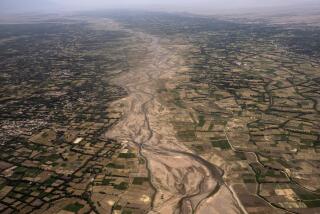2 Die as 6.8 Quake Rocks Eastern Mediterranean
- Share via
CAIRO — A strong earthquake beneath the eastern Mediterranean sent shock waves Wednesday across Egypt, Israel, Cyprus, Lebanon and Turkey, spreading panic that transcended the Middle East’s usual political fault lines. Buildings swayed and cracked, roads were blocked, and at least two people died.
One woman was killed when her one-story house in a village in Egypt’s Nile Delta fell in, officials said, and a 73-year-old patient suffered a fatal heart attack while being led down a flight of stairs to a place of safety at a hospital in Limassol, Cyprus. Twenty people also were hurt in Cyprus, mainly from running over each other in the crush to evacuate buildings.
The quake occurred at 3:11 p.m. and was centered about 25 miles southwest of the Cypriot port of Paphos. Its magnitude was 6.8, the U.S. Geological Survey reported.
Experts blamed Wednesday’s temblor on a fault in that part of the Mediterranean resulting from the slow movement of the continents, said Falkhonda Hassan, geology professor at the American University in Cairo.
She explained that Africa is drifting north and pressing against the tectonic plate of the Eurasian continent--the same collision that has crumpled the Earth’s crust to create the Alps and caused quakes in Egypt that were recorded in the time of the pharaohs 4,000 years ago.
But modern construction technology--putting up spindly high-rises as opposed to the traditional low, thick-walled structures of the past--makes today’s residents of the Middle East much more vulnerable to earthquakes than their ancestors ever were, she noted.
Throughout the region, people experienced a common stab of terror when in midafternoon their chandeliers moved, pottery fell and plaster cracked.
“I was cooking the pasta and I felt like I was dizzy,” said Stana Chlpekova, a resident of central Cairo. “Then I realized the whole building was moving. I was so scared, my knees were still shaking a half-hour later.”
In Paphos, drivers left vehicle motors running and ran from cars, state-run Cyprus radio reported. Landslides blocked mountain roads, and several churches were reported to be nearly toppled.
In the Gaza Strip, near the Erez checkpoint where Israeli and Palestinian negotiators have been deadlocked this week over how to bring peace between their peoples, talk of politics was suspended as frightened Palestinian shopkeepers raced into the streets.
In the fashionable seafront area of Tel Aviv to the north, Israeli residents evacuated high-rises.
The quake lasted not more than two minutes.
It was followed by dozens of aftershocks into the evening, most too weak to be detected without scientific instruments.
This was the third deadly earthquake in four years in Egypt. All, coincidentally, took place at about the same time of year.
“We are calling October the month of earthquakes,” Cairo jeweler Soliman Dawoud Soliman said.
A calamitous quake rocked Cairo on Oct. 12, 1992, killing more than 450 people and injuring 4,000. The magnitude of that temblor was only 5.6, but the epicenter’s location, just to the south of the densely populated city, was so close that apartment buildings collapsed, causing many of the deaths.
Then, last November, an earthquake centered in the Gulf of Aqaba killed eight people.
Egyptian state television assured viewers that there was no link between Wednesday’s quake and a rise in the Nile River, which this year has had a record flood, raising the water depth behind the High Dam at Aswan to 587 feet.
The dam, more than 1,000 miles to the south of Wednesday’s epicenter, was not threatened or harmed by the quake, said dam authority Chairman Mina Iskandar. By design, it is supposed to withstand mighty quakes of magnitude 8.
More to Read
Sign up for Essential California
The most important California stories and recommendations in your inbox every morning.
You may occasionally receive promotional content from the Los Angeles Times.













